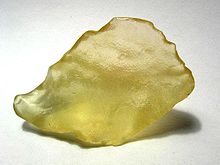Libyan desert glassorGreat Sand Sea glass is an impactite, made mostly of lechatelierite,[1] found in areas in the eastern Sahara, in the deserts of eastern Libya and western Egypt. Fragments of desert glass can be found over areas of tens of square kilometers.


The origin of desert glass is uncertain. Meteoritic origins have long been considered possible, and recent research links the glass to impact features, such as zircon breakdown, vaporized quartz and meteoritic metals, and to an impact crater.[2][3][4][5][6][7][8] Some geologists[9] associate the glass with radiative melting from meteoric large aerial bursts, making it analogous to trinitite created from sand exposed to the thermal radiation of a nuclear explosion. Libyan Desert glass has been dated as having formed about 29 million years ago.[10] Like obsidian, it was knapped and used to make tools during the Pleistocene.[11]
For decades, ideas about how the glass formed included melting during meteorite impact and melting caused by an airburst from an asteroid high in Earth's atmosphere. In May 2019, Libyan desert glass samples were examined by Aaron Cavosie of Curtin University[12] via the electron backscatter diffraction (EBSD) technique, and the results were published in the Journal of Geology : the glass is nearly pure silica which requires temperatures above 1,600 °C to form – hotter than any igneous rock on Earth. However, few mineral relics survived from whatever caused the melting, including a form of silica called cristobalite (a rarely occurring high-temperature mineral) and grains of the mineral zircon derived from reidite, although most have reacted to form a higher-temperature compound called zirconia when the melt reached over 1,700°C. The presence of still remaining zircon grains transformed from reidite (circa 10%), their orientation and shape revealed to be typical only of a meteoritic impact. Moreover, airbursts never yield this exact type of mineral transformation according to geological records.[10][13]